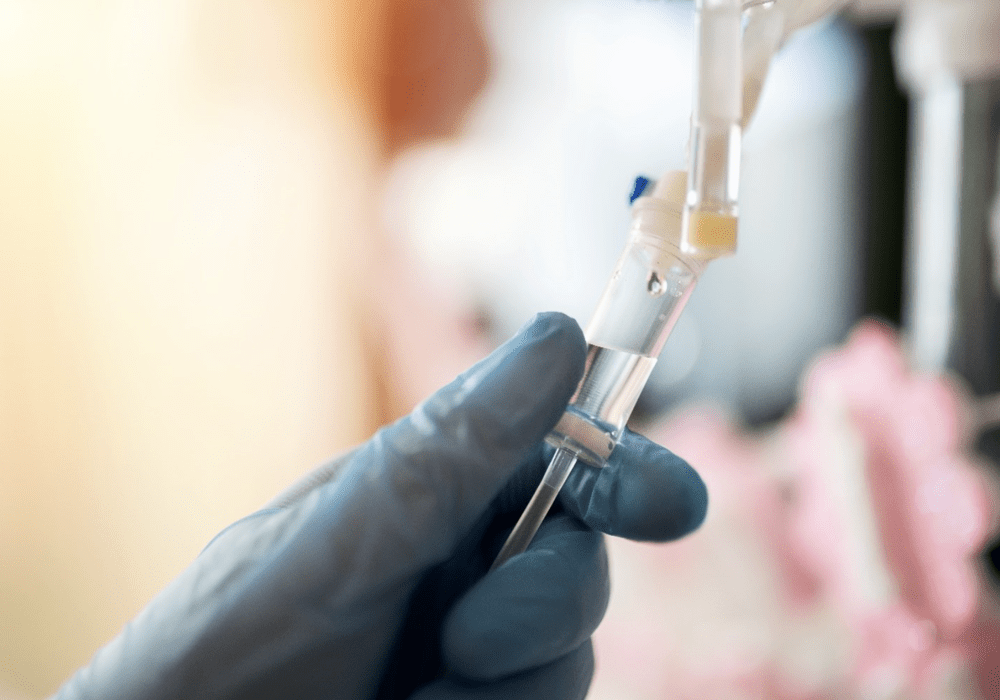After an open-label, multicenter, single-arm trial demonstrated a 56% objective response rate, with 43% achieving complete responses, and an estimated 18.4-month median duration of response, the U.S. Food and Drug Administration granted glofitamab-gxbm (Columvi™) accelerated approval in June 2023.
Category/Class
Bispecific CD20-directed CD3 T-cell engager
Mechanism of Action
Binds to CD20 expressed on the surface of B cells and to CD3 receptor expressed on the surface of T cells resulting in T-cell activation and proliferation, cytokine secretion, and CD20-expressing B cell lysis
Indication
Adults with relapsed or refractory diffuse large B-cell lymphoma, not otherwise specified (DLBCL, NOS), or large B-cell lymphoma (LBCL) arising from follicular lymphoma who have received two or more lines of systemic therapy
| Treatment Cycle (21 Days) | Day | Administration |
|---|---|---|
| Cycle 1 | 1 |
Obinutuzumab 1,000 mg (no glofitamab-gxbm) |
| 8 |
Glofitamab-gxbm 2.5 mg (step-up dose 1) |
|
| 15 |
Glofitamab-gxbm 10 mg (step-up dose 2) |
|
| Cycle 2-12 | 1 |
Glofitamab-gxbm 30 mg |
Administration
On cycle 1, day 1, give pretreatment with a single dose of obinutuzumab (1,000 mg) via IV at 50 mg/hour with the option to titrate in 50 mg/hour increments every 30 minutes to a maximum of 400 mg/hour. Administer additional premedications per the chart below.
Infuse glofitamab-gxbm via a dedicated line with a sterile 0.2 micron in-line filter. Infuse cycles 1 and 2 over four hours; cycles 3–12 may be infused over two hours. If a patient experienced cytokine release syndrome (CRS) with the previous dose during cycles 3-12, the infusion time should be maintained at four hours.
| Treatment Cycle | Premedication | Administration |
|---|---|---|
| Cycle 1, day 8 and 15; Cycle 2; Cycle 3 | IV dexamethasone 20 mg | Complete at least one hour prior to glofitamab-gxbm |
| Oral acetaminophen 500–1,000 mg |
Administer at least 30 minutes prior to glofitamab-gxbm |
|
|
Oral or IV diphenhydramine 50 mg (or equivalent) |
Complete at least 30 minutes prior to glofitamab-gxbm |
|
| All subsequent infusions |
Oral acetaminophen 500–1,000 mg |
Administer at least 30 minutes prior to glofitamab-gxbm |
|
Oral or IV diphenhydramine 50 mg (or equivalent) |
Complete at least 30 minutes prior to glofitamab-gxbm |
Note. Patients who experienced any grade CRS with a previous dose of glofitamab-gxbm should receive IV dexamethasone 20 mg one hour prior to infusion.
Adverse Reactions
More than 20% of patients in the clinical trial experienced CRS, musculoskeletal pain, rash, and fatigue. Laboratory abnormalities (grade 3 or 4) included decreased lymphocyte count, decreased phosphate, decreased neutrophil count, decreased fibrinogen, and increased uric acid. The package insert contains warnings for CRS, neurologic toxicity, serious infection, tumor flare, and embryo-fetal toxicity.
Nursing Considerations
Patients should be hospitalized during administration and for 24 hours after their first dose and as indicated for any subsequent doses (e.g., CRS with previous dose). Administer glofitamab-gxbm in a setting equipped to monitor and treat CRS. Patients at risk for tumor lysis syndrome (TLS) should be adequately hydrated and receive antihyperuricemics before glofitamab-gxbm. Verify pregnancy status prior to infusion. Monitor patients for neurologic toxicity.
Patient Education
Use effective contraception during and for one month after treatment with glofitamab-gxbm. Do not breastfeed during and for one month after treatment. Carry a wallet card at all times that describes CRS’s symptoms and when to seek medical attention. Glofitamab-gxbm treatment may need step-up dosing and hospitalization for monitoring after infusion.
Safe Handling
Glofitamab-gxbm can cause embryo-fetal toxicity; use safe-handling precautions.
Patient Assistance
Call 866-422-2377 or refer to the Columvi Financial Support Tool.






